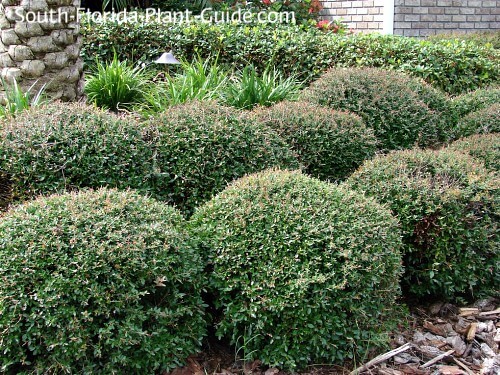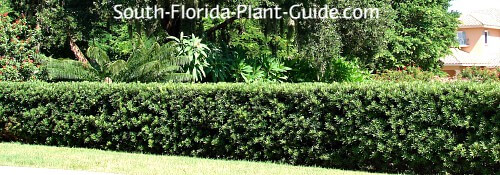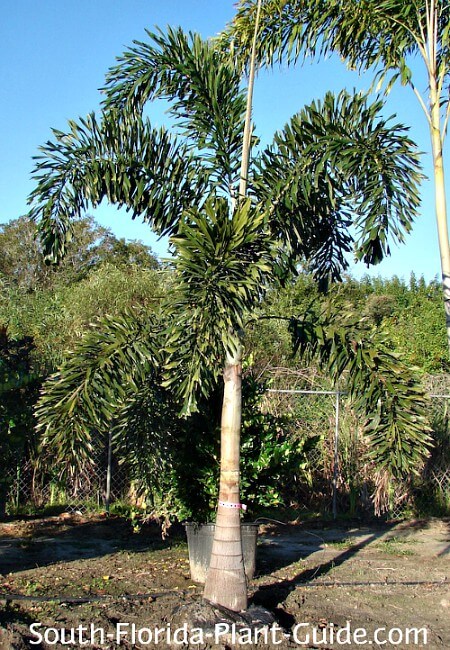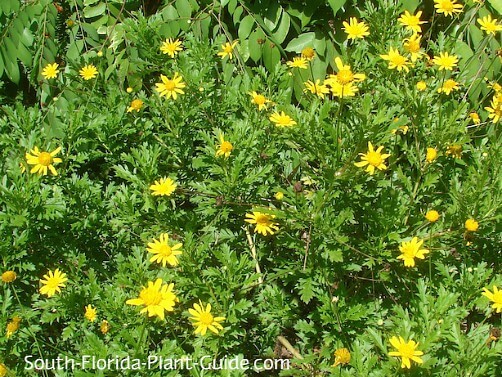Plant Trimming
Plant trimming in South Florida can be a steady pastime. Here are tips on when and how to trim, how much to take off, and ways to keep this garden chore to a minimum.

All plants require a trim sometime...
...whether to keep them the height or shape you want, or to remove dead or dying fronds or leaves.
When to trim
There's trimming and then there's hard pruning.
Plant trimming is shaping. This can be done any time of year in South Florida.
Hard pruning - cutting back up to one-third to even one-half of a plant - should only be done in warm months...March 15th through October 15th.
Always water well before giving a plant a hard pruning.
This isn't necessary for shaping, just heavy pruning. Wait at least an hour after watering to start cutting things back.
If you cut a plant back hard in cooler weather, the new growth that emerges may be hit hard by cold. (See the Cold Protection page for more wintertime tips.)
Snowbirds: give your landscape plants a hard pruning just before you leave for the summer.
Once a year is fine for pruning most plants.
Certain plants like azaleas are best left alone - trim or prune - until after they've finished their blooming season.
Cutting back after a bloom cycle on things that flower on and off all year will encourage new growth and more blooms, especially if you fertilize when you cut.
The Plant Pages will give you tips for each plant...
...on shaping or pruning, the growth rate, and the ultimate height or at what height you can keep it.

Growth rates can dictate how much plant trimming you'll need to do
Plant growth rates are classified simply as slow, fast or moderate. And no two plants...even of the same variety...grow at the same pace.
Some plants grow fast for a while and then settle into a more moderate pace.
Traveler's Palm, for instance, grows fast until it starts developing a trunk...then its growth rate becomes more moderate.
But most keep the same pace all their lives. So how much plant trimming you have to do can depend on whether you use fast growing plants or those that have a slow or moderate rate of growth.
Sometimes you want a faster grower for privacy or shade. And if you want instant gratification - especially with a slow grower - buy a bigger, more mature specimen.
There are no definite numbers.
A plant's growth rate doesn't indicate it will grow a certain number
of inches (or feet) in a year. A lot depends on placement, fertilizing
and other care - and, of course, Mother Nature.
Trimming palm trees
Unless a palm is considered "clustering," sending up many shoots, never cut a palm tree's trunk.
The head of a palm is its heart and soul, and if you chop its head off it's a goner.
Many multi-trunk palm specimens are considered "solitary," but with 2 or 3 palms planted together. Solitary palms cannot be cut back.
Clustering palms like arecas can be thinned out - some trunks cut to the ground while others are left to grow and fill in.
Some palms - like the foxtail palm pictured below - are self-cleaning, meaning they'll shed dead fronds on their own.

Others will need to have browned fronds cut off. And some
will be too tall eventually to do yourself...these palms can be left to
sport a "petticoat" of dead fronds around the base of their green tops. The old fronds will fall off on their own eventually, but some petticoat is usually always present.
Trimming shrubs
Leaf trimming vs. stem trimming: Some shrubs like viburnum can take a manicured shaping with hedge trimmers.
Others, such as junipers, need to be hand trimmed by cutting branches rather than across foliage.
Certain shrubs like arboricola look best when stems rather than leaves are cut.
And a few like Texas sage benefit from an alternating pruning (cutting some branches taller, others shorter).
(No worries: The Plant Pages give instructions for each plant.)
How often and how you go about trimming bushes can depend on the look you want - formal or informal. A more informal landscape doesn't require regular sculpting but rather only cutting to shape now and then - and usually a hard pruning in spring.
Trimming trees
For larger trees, this is best left to a professional. For smaller, reachable trees such as desert cassia doing it yourself after a bloom cycle (if it even needs it) works fine.
Tips for low-maintenance plant trimming
Use plants that rarely need shaping. Philodendron, for instance, only needs a dead or dying leaf and stem removed occasionally.
Slow growers like Japanese boxwood or podocarpus need attention less often.
Horizontal growth patterns means plants such as junipers grow outward, rather than up.
Look for self-cleaning palms such as foxtail and adonidia (Christmas) palm.
Space plants so they have room to fill out, rather than competing and reaching for light.
A few plants need a regular "haircut" for health or beauty

Bush daisy - pictured above - is one plant that will live a longer, healthier life by cutting it back a bit every few months.
Mexican heather also needs an occasional trim to keep it healthy and full.
Lantana, especially the older cultivars, get leggy after a while. Even though they may be full of blooms, cut them back to encourage bushiness and new growth.
Take a break!
The ultimate guide to low-maintenance plants
and landscaping!
An ebook by
Chase Landre
author of
South-Florida-Plant-Guide.com
Learn more!
Get a greener thumb!
Want to learn more about South Florida planting, watering, fertilizing and dealing with weeds and pests?
See our Gardening How-To section for answers!
Get instant curb appeal!
An ebook by
Chase Landre
author of
South-Florida-Plant-Guide.com
Learn how to get instant curb appeal with fast growing plants and landscaping techniques!



